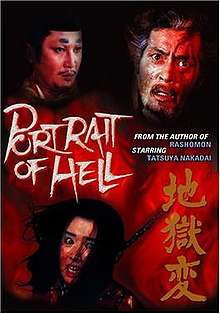Portrait of Hell
Portrait of Hell (地獄変, Jigokuhen) is a 1969 Japanese jidaigeki film directed by Shirō Toyoda and starring Tatsuya Nakadai and Kinnosuke Nakamura. The film is based on the "Tokyo nichi nichi" serial, Jigokuhen by Ryunosuke Akutagawa.[1]
| Portrait of Hell | |
|---|---|
 DVD cover | |
| Directed by | Shirō Toyoda |
| Produced by | Tomoyuki Tanaka[1] |
| Screenplay by | Toshio Yasumi[1] |
| Based on | Jigokuhen by Ryunosuke Akutagawa |
| Starring |
|
| Music by | Yasushi Akutagawa[1] |
| Cinematography | Kazuo Yamada[1] |
Production company | |
| Distributed by | Toho |
Release date |
|
Running time | 95 minutes[1] |
| Country | Japan |
Plot
The story, set in the Heian period, depicts the conflict between Korean painter Yoshihide (Nakadai) and his Japanese patron, the cruel and egotistical daimyō Hosokawa (Nakamura).
Horikawa demands that Yoshihide decorate the walls of his new temple with an image of Buddha, but Yoshihide refuses, insisting that he cannot paint what he does not see. In Hosokawa's realm, Yoshihide can see nothing but the suffering of peasants. He creates several gruesome images that appear to have some sort of magical power. (For example, a painting of a man killed by Hosokawa's soldiers at the beginning of the film gives off the stench of a rotting corpse.) These all appall Horikawa, and he demands that the paintings be destroyed.
Ultimately, Yoshihide asks that he be allowed to portray hell on a screen for the wall of the temple, and Horikawa agrees. Yoshihide asks for one thing to be in the centre of his painting: a burning carriage with Horikawa in it. Hosokawa agrees to this, but to provide a model for the scene, he has Yoshihide's daughter, Yoshika (played by Yoko Naito), chained in the carriage. Yoshihide watches in horror as his daughter is burned alive, before going on to paint his masterpiece.
Before the completed screen is unveiled, Yoshihide hangs himself. When Hosokawa looks at the screen, he is horrified to see himself portrayed in hell. The climax of the film is slightly vague, but the audience is led to believe that Horikawa becomes trapped in his own private hell through the power of the portrait.
Release
Portrait of Hell received a roadshow theatrical release on September 20, 1969 by Toho.[1] It received general release in Japan on 27 September 1969.[1]
The film was released by Toho International with English subtitles in the United States on 18 November 1969.[1] It was re-issued by Toho International theatrically again in April 1972.[1] The film has been released under other titles, including A Story of Hell and The Hell Screen.[1]
References
Footnotes
- Galbraith IV 2008, p. 259.
Sources
- Galbraith IV, Stuart (2008). The Toho Studios Story: A History and Complete Filmography. Scarecrow Press. ISBN 1461673747. Retrieved October 29, 2013.CS1 maint: ref=harv (link)
External links
- Portrait of Hell on IMDb
- Portrait of Hell at the Japanese Movie Database (in Japanese)